Verstappen crowned champion amid confusion of 2022 Japanese Grand Prix: race report
The unpredictable 2022 Japanese Grand Prix brought a rain delay, a troubling safety scare and widespread confusion over Formula 1 points scoring, but out of it all came the inevitable: a second world championship for Max Verstappen
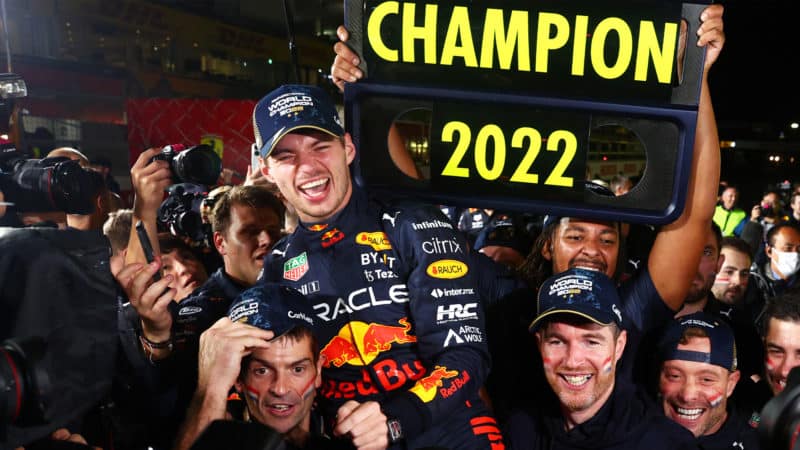
Can Verstappen beat the F1 season wins record?
Red Bull
One day, Max Verstappen will get to win a world championship in normal, uncontroversial circumstances.
2022 had none of the controversy of 2021, but it completely outdid it in terms of confusion, and probably involved far worse handling of aspects of the race when you take the potential outcomes into account.
While last year’s interpretation of the regulations still hurts for many, it didn’t put any lives at risk. Early in the Japanese Grand Prix, lives were.
Light rain started with an hour to go before the race, and started to intensify to ensure all cars started on intermediate tyres. For a split second, it looked like it would prove to be costly conditions for Verstappen, as Charles Leclerc took the lead on the run to Turn 1, but Verstappen showed that admirable single-mindedness to his racing and remained as combative as ever, risking it round the outside of the first two corners to regain the lead.
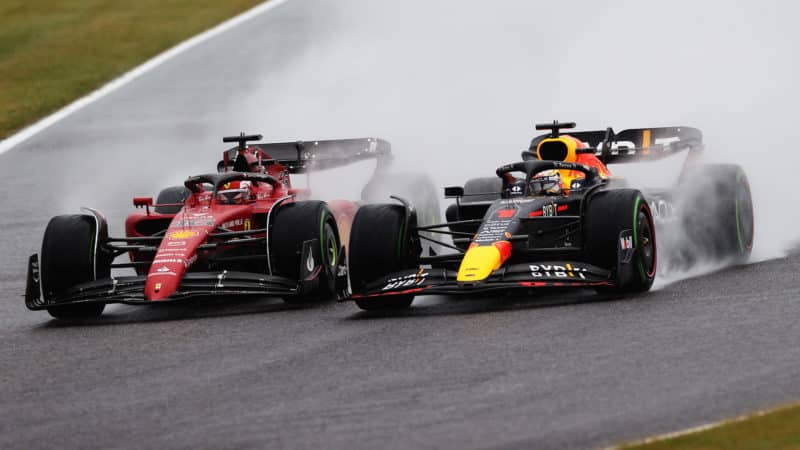
Leclerc seized the lead from the start but Verstappen was in no mood to concede the place
Bryn Lennon/F1 via Getty Images
And soon the conditions were extremely costly for the other Ferrari of Carlos Sainz, as he aquaplaned on the run to Spoon and crashed heavily.
“Obviously disappointed for crashing the car and for the team but at the same time the conditions were pretty much impossible with the visibility and the intermediate tyres,” Sainz said. “The aquaplaning was crazy.
“I tried to get out of Checo [Perez]’s slipstream to see something, but as soon as I got out of the slipstream I had more water on the tyre and went into aquaplaning which sent me into a spin, and then you’re down to luck because you know everyone coming behind you doesn’t see you. They cannot see where you are and you’re in the middle of the track so you are kind of praying for anyone not to hit you.”
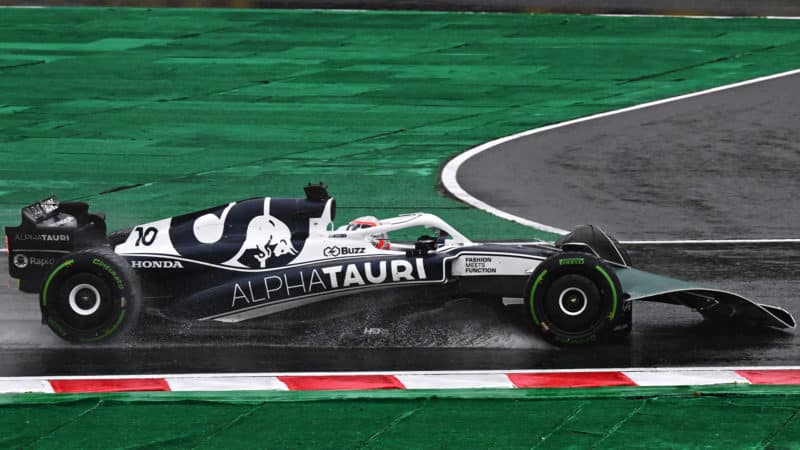
Collision with advertising hoarding led to Gasly finding himself uncomfortably close to recovery vehicle
Clive Mason/Getty Images
The crash led to the safety car being deployed, but not before Pierre Gasly had collected an advertising board that had flown onto the track as a result of Sainz hitting the barrier, breaking Gasly’s front wing. He stopped for full wet tyres and a new wing, then was catching up to the back of the pack when he passed a light panel just before the crash site.
As Gasly passed the panel at high speed, the red flag came out, and just under two seconds later he passed a recovery vehicle on track that was tough to spot in the gloomy and wet conditions. Flashbacks of Jules Bianchi’s fatal crash eight years ago followed, and Gasly was rightly apoplectic.
“God, what the… what the… What is this?” Gasly said over team radio. “What is this tractor on track?! I passed next to it. This unacceptable. Remember what has happened. Can’t believe this.”
He raced back to the pits — at speeds that would later earn him a penalty — where he was joined by a number of drivers and team bosses condemning the situation.
“It is a kink, so you don’t really see it and there is a safety car, we have a delta lap time to respect and I was nine seconds slower than the delta lap time,” Gasly explained. “So I am catching the queue and then I saw it at the last minute, and when I see it, I am doing 200km/h [124mph].
“I tried to slow down but not in an erratic manner, because if I slammed on the brakes I would’ve lost the car and I would’ve ended up in the crane. I came past two metres on the right, two metres away from passing away today, which I don’t think is acceptable as a race driver.”
He wasn’t alone holding that view, and the drivers had time on their hands to comment, because an attempt to restart the race 40 minutes later was aborted due to further rain, and in the end it was two hours before conditions improved enough to get back on track. With everyone on full wet tyres, two laps were completed behind the safety car before the decision to restart was taken.
By now, the race was being constrained by the three-hour time limit to hold the event in, even with red flag delays, and so it was ambitious to think half distance would be reached. The belief – at this point – was that limited points would be on offer.
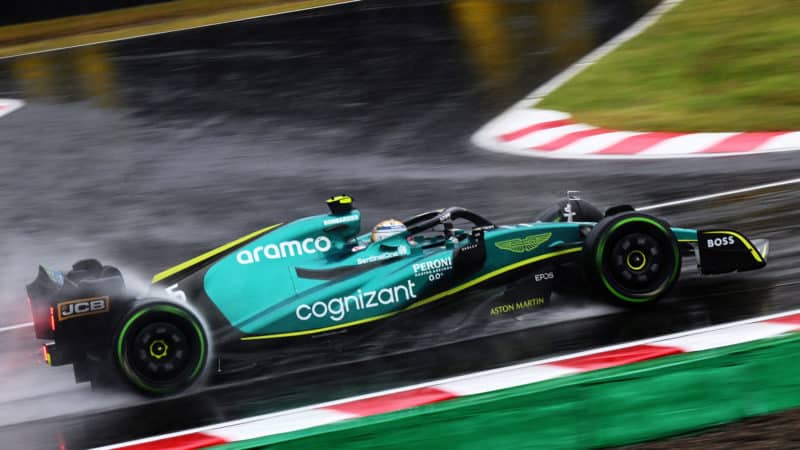
Early switch to inters reversed Vettel’s fortunes in the race
Clive Mason/Getty Images
Restarting with 40 minutes to go, the conditions had still looked challenging behind the safety car but two cars immediately came into the pits for intermediate tyres. Sebastian Vettel had spun after contact with Fernando Alonso on the original race start so was at the back, and he just beat Nicholas Latifi out of the pit lane.
Their pace instantly told the field it was the time to switch tyres, with Lando Norris and Valtteri Bottas following suit a lap later. Then the majority of drivers did the same, with Alonso staying out to lead Daniel Ricciardo for a lap before they both came in. That promoted Mick Schumacher to the lead for all of five seconds, before Verstappen swept by.
On what was officially Lap 11, Schumacher went from fifth ahead of Lewis Hamilton to tenth place and finally gave up his hopes of a safety car interruption handing him a free stop. It was still good to prolong his stint, however, because the intermediates were proving to be a challenge.
Leclerc had kept Verstappen honest for a few laps on the restart but dropped five seconds adrift, and then on Lap 14 saw the gap start to grow quickly. The Ferrari driver was struggling with his front tyres, while Verstappen was in a league of his own.
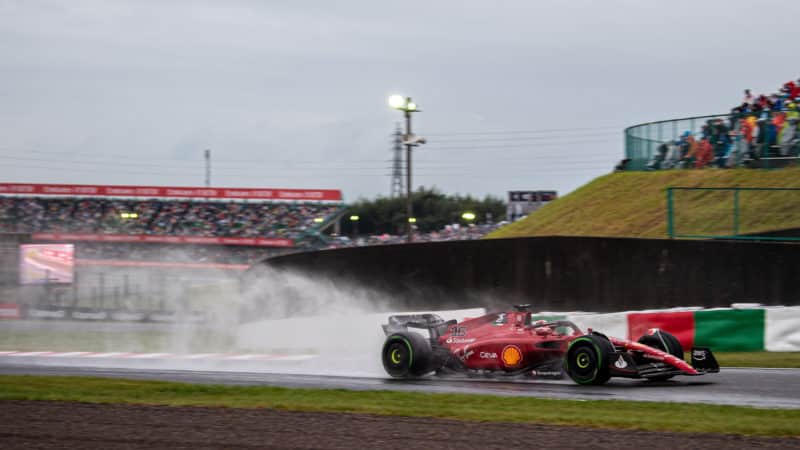
Tyre struggles saw Leclerc drop back from the race leader
Ferrari
George Russell had been angered by an early stop but started fighting back through the field, passing Yuki Tsunoda around the outside of Turn 6 with a crisp move, and doing the same to Latifi – at this stage running in the top eight – on Lap 20.
It was at this stage that Zhou Guanyu had made a second stop for more intermediates and he duly set the fastest lap to show their value, with Gasly and Lance Stroll also gambling further back. But it was Alonso who risked the most, pitting on Lap 22 to drop from seventh to tenth with just eight minutes remaining.
With no interruptions, that was enough time for Verstappen to reach the end of Lap 28 within the time window, exceeding half distance in what every team and driver thought would mean a 19-point victory.
24 seconds behind him, Leclerc had continued to struggle and came under huge pressure from Perez, but was holding on until the final chicane on the final lap, running deep and blocking the Red Bull after he rejoined. The stewards investigated and relegated Leclerc to third with a five-second time penalty.
“I did a mistake, I tried to minimise it obviously by trying to go straight – I was not aware this was the last lap – but a five-second penalty was the right thing to do to be honest,” Leclerc said.
“From lap five onwards to be honest it was all downhill, really struggling with the tyres. A bit like the last race, we are really strong warming up the tyres but then after three or four laps we just destroy them, so I struggled this time.”
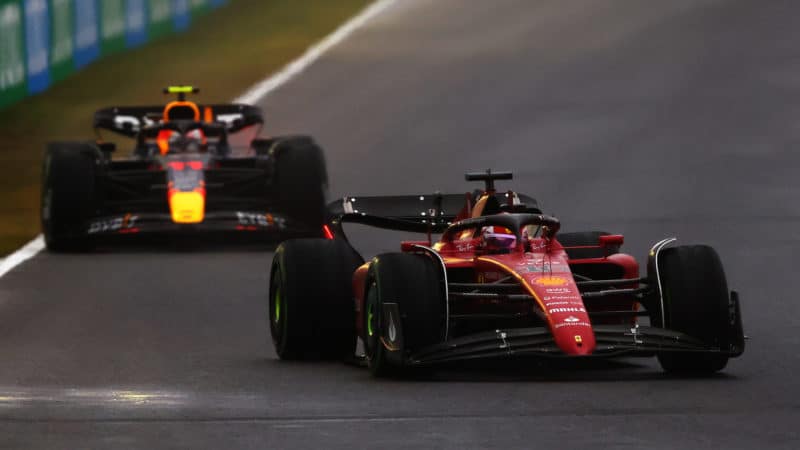
Perez put the pressure on Leclerc in the final laps and the tactic bore fruit at the final corner
Bryn Lennon/F1 via Getty Images
That initially appeared to leave Verstappen one point short of the title. But it proved the clinching moment, as a quirk of the regulations meant full points should be awarded as the race had been running when the time limit was reached – and not suspended – confirming Verstappen as world champion.
“To be honest I don’t mind that it was a little bit confusing, I find it actually quite funny!” Verstappen said. “Because at the end of the day it’s not going to change the result. When I crossed the line it was anyway not enough even if you give full points, in that scenario it wouldn’t have changed anything.”
At least Verstappen’s laughing, but he was still robbed of a true moment of celebration and clear holes in the regulations were exposed. It also meant full points for those off the podium, including Esteban Ocon who held Hamilton at bay for fourth, and Vettel whose early stop paid off with a strong sixth, beating Alonso to the line by just 0.011sec.
Russell recovered to eighth ahead of Latifi’s first points of the season with a very impressive ninth, and Norris rounding out the top ten.
As darkness fell over Suzuka, it was an anticlimactic end to a race that left plenty to be desired in terms of the way it was run, too. But it should not detract from another sublime Verstappen performance that cemented a fully-deserved second drivers’ championship.
